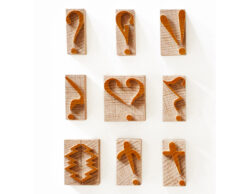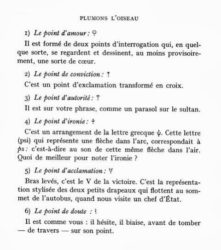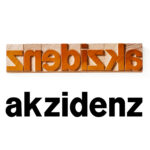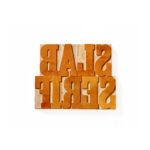Extra Punctuation Wood Type
Human interaction is based on a mixture of verbal and nonverbal communication. We mostly use the verbal part to convey information, while relying on the nonverbal to express our intent, feelings and attitude towards what is being said. This has always raised a challenge for the written language, with some solutions being sought, for marking irony or sarcasm, or a rhetorical question – as done with the percontation point, introduced by Henry Denham, as early as the 1580′. The need becomes more apparent with shorter texts, where context is missing.

Perhaps the best example for short message human interaction, the contemporary internet chat, that we may very well recognize as governed by Pow’s law. Poe’s law is an adage of Internet culture stating that, without a clear indicator of the author’s intent, it is impossible to create a parody of extreme views so obviously exaggerated that it cannot be mistaken by some readers or viewers as a sincere expression of the parodied views. The solution for instant messaging was found in the abundantly available, and the well in use, emoticons. However, their typographic relatives, although created a longer time ago, have not found their place in our current visual representation system. Although used before in news articles, diplomatic writings and novels, to clarify meaning; it is our belief, that their use is best justified at incorporating the most emotional accuracy, within the smallest amount of words.
The set of punctuation that Petrescu Press propose, are meant to support the printer in doing just that.

The Percontation Point
The percontation point (⸮), a reversed question mark later referred to as a rhetorical question mark, was proposed by Henry Denham in the 1580s and was used at the end of a question that does not require an answer — a rhetorical question. Its use died out in the 17th century.
The Irony mark
In 1668, John Wilkins proposed using an inverted exclamation mark to punctuate ironic statements. In 1841, Marcellin Jobard, a Belgian newspaper publisher, introduced an irony mark in the shape of an oversized arrow head with small stem. Later, an irony point (⸮) (French: point d’ironie) was proposed by the French poet Alcanter de Brahm (alias Marcel Bernhardt) in his 1899 book L’ostensoir des ironies to indicate that a sentence should be understood at a second level (irony, sarcasm, etc.). In March 2007, the Dutch foundation CPNB presented another design of an irony mark, the ironieteken. It’s purpose is to convey the opposite of the sentence’s literal meaning.
The Sarcastheses
Are a variation on the irony mark, meant to incorporate a larger segment of text.
The Interrobang
The interrobang , also known as the interabang, ‽ (often represented by ?! or !?), is a nonstandard punctuation mark used in various written languages and intended to combine the functions of the question mark, or interrogative point, and the exclamation mark, or exclamation point, known in the jargon of printers and programmers as a “bang”. The glyph is a superimposition of these two marks. A sentence ending with an interrobang asks a question in an excited manner, expresses excitement or disbelief in the form of a question, or asks a rhetorical question.
Herve Bazin’s Punctuation
Herve Bazin, (17 April 1911 – 17 February 1996) was a French writer, in his 1966 essay Plumons l’Oiseau (“Let’s pluck the bird”), proposes six innovative punctuation marks: an irony point, doubt point, certitude point, acclamation point, authority point and love point. This is how he defines them:

Irony point
It is an arrangement of the Greek letter Ψ. this letter, which represents an arrow in the arc, corresponds to ps: that is, to the sound of that same arrow in the air. What better way to note the irony?
Doubt point
His meaning is: he is like you, he hesitates, he skews, before falling, crooked, on his point.
Certitude point
It is an exclamation point transformed into a cross.
Acclamation point
The raised hands are the V of victory. It is the stylized representation of the two little flags that float at the top of the bus, when a head of state visits.
Authority point
He is on your sentence, like an umbrella on the sultan.
Love point
It is formed of two question marks which, as it were, look at each other and draw, at least temporarily, a kind of heart.
You can find this item in our shop.










